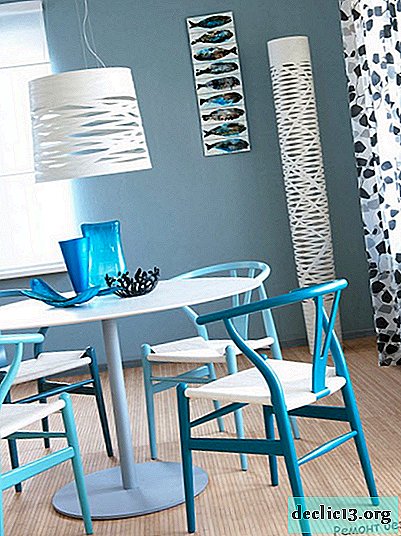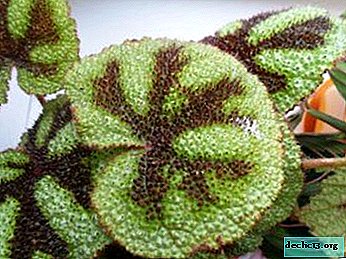How to care for room begonia in a pot?

Begonia is a delicate and long flowering plant and quite moody. This is due to the features of the root system, which grows more in breadth than in the depths of the pot.
Therefore, one of the conditions for the beauty and health of begonias is the selection of the right flowerpot. It creates a special environment necessary for the successful development of the plant.
Having made a decision to grow begonia, it is necessary to study what characteristics a container designed for keeping a flower should have, or rather, in which pot to plant.
Plant description
Begonia is an annual or perennial plant of the Begoniaceae family. Depending on the species, plants have a different shape: from grass crawling on the ground to tall erect bushes or shrubs. The begonia leaf is asymmetric, can be solid or dissected with wavy or jagged edges.
Inflorescences consist of several small, medium or large flowers. Their coloring is monophonic red, pink, yellow, orange, white or with a fringing of various shades along the edges of the petals. It is time for the plant to bloom - summer and autumn; indoor begonia can bloom until December. The fruit is a small box with small seeds inside.
Photo of flowers
Here you can find a photo of a begonia flower in a pot.





Root system features
There are three types of root system of begonias:
- Tuberous. It is characterized by proliferation in the form of a spherical, and subsequently flat-round tuber. It is formed in the lower portion of the stem. A branched root system forms in the lower part of the tuber. This type is possessed by decorative leaf varieties of begonias.
- Rhizome Plants form fleshy, horizontally located rhizomes with numerous small roots. Rhizomes are pubescent and bear leaves with stipules. More common in flowering varieties.
- Ramified root system without pronounced modifications.
The roots of all types of begonias are usually located in the upper layers of the soil, grow more in breadth than in depth. They are thin and easily injured during rough handling.
The soil
Requirements
- Optimal soil acidity pH: from 6.1 to 7.5.
- Begonia loves a soil rich in nutrients.
- The soil must have good drainage properties.
- It is not recommended to take the soil at home, in the country or in the forest. Such land is almost always infected with diseases and insects, and its acidity is unknown.
Mix Recipes
Mixture for germination of tubers:
- moss - 1 part;
- sheet land - 1 part;
- perlite - 1 part.
For tuber begonia:
 sand - 2 parts;
sand - 2 parts;- turf land - 1 part;
- sheet land - 2 parts.
For the royal:
- sheet land - 2 parts;
- peat - 2 parts;
- humus - 2 parts;
- turf land - 1 part.
For ever flowering:
- sand - 1 part;
- humus - 1 part;
- sheet land - 2 parts;
- peat - 1 part.
Watering
To ensure optimal conditions for growth, it is necessary to water the plant, observing certain rules:
- Depending on the air temperature in the room, it is required to water the begonia once every 2-3 days.
- Watering is necessary evenly, preferably at the same time of day.
- Watering is carried out in the morning or in the evening.
- In the summer, water abundantly, so that excess water flows out of the drainage holes. This is especially important in hot, dry weather. If the soil in the pot is completely dry, you need to soak the pot in water for several hours.
- Starting in mid-autumn, watering intensity decreases. In winter, the plant is at rest. Watering is minimal. Begonia should be watered as the soil dries in a pot - 1 time in 5-7 days. Read more about caring for begonia in the winter in this article.
- After the soil absorbs all the water, carefully loosen it to a depth of 1-2 cm. This will maintain optimal moisture inside the pot and ensure good air exchange.
- You can water begonias using the pot immersion method. In a shallow container, the diameter of which is larger than the diameter of the pot, you need to pour water and put a pot in it. Leave until water is absorbed into the soil through drainage holes.
- For irrigation of begonias, it is advisable to use warm, settled tap water. Water should be defended in an open container for at least a day. To mitigate, you can filter it with a normal household filter or bring to a boil and cool.
- After watering, be sure to drain excess water from the pan. Begonia does not tolerate stagnation of water in a pot.
- Begonia leaves are thin, so you need to avoid getting water and dirt on them when watering. Do not spray the leaves.
You can learn how and how to water begonia in another article.
What capacity is needed for landing?
The size
Note! Given the structural features of the root system, it is necessary to give preference to containers whose diameter slightly exceeds the height.The size of the pot depends on the purpose of planting. Cuttings that have already begun to take root are planted in containers measuring 5-6 centimeters. In pots there must be several drainage holes.
 After 6 months, when the root system already encompasses an earthen lump, begonia needs to be transplanted into a pot measuring 8-10 centimeters. If the first landing was carried out in the spring, after a year, an even larger container is selected. It is determined based on the size of the resulting root system.
After 6 months, when the root system already encompasses an earthen lump, begonia needs to be transplanted into a pot measuring 8-10 centimeters. If the first landing was carried out in the spring, after a year, an even larger container is selected. It is determined based on the size of the resulting root system.
The flowerpot should be one third more than before. It is impossible to choose too spacious a container for begonia from the first try. The root system of a plant can rot. When separating an overgrown begonia, the diameter and height of the flowerpot for each of the separated parts is 2-3 cm less than the previous one. When separating young outlets, children are temporarily placed in seedlings 60 to 60 millimeters in size.
The form
For begonias it is better to take a regular round pot. The shape of the container should not complicate the process of plant transplantation.
Material
Ceramic pots are more suitable for the normal operation of the begonia root system. They do not retain moisture and provide good air circulation.
Plastic can also be used if you choose the right soil, provide good drainage and prevent overheating or overcooling of the tank.
On a note. You should not buy popular glass pots for begonias. Such flowerpots are poorly functional, and there is no decorative effect when growing plants in a normal substrate.Read about how to properly care for a plant grown in a pot here.
Training
If the pot remains unchanged during plant transplantation, you need to disinfect it by placing it in a weak solution of potassium permanganate for 30 minutes. The lower third of the begonia pot is necessarily filled with drainage - a layer of expanded clay and coarse sand. In order to prevent rot, it is covered with a layer of charcoal with a thickness of 2-3 centimeters.
How to plant?
Planting a plant can be carried out independently, using parts such as stems, tubers, leaf cuttings, as well as a vegetative method.
Rhizome planting
The pot should be four centimeters larger than the diameter of the root system. Planting begonias in a pot is a little more carried out in the spring, as well as transplanting. The bottom of the pot must be filled with drainage of 2-3 centimeters. Next, pour a layer of charcoal, which will help prevent rot.
Mix the soil enriched with vitamins, with river sand and humus, you can add peat. Young begonia poorly perceives the increased acidity of the soil. It should be within 5.5 pH. Young plants tolerate planting well, so after watering they can be immediately put on a permanent place.
Important! Begonia grows a large number of fragile young leaves with age. Florists often cut it or make rejuvenation by dividing rhizomes.Tuber planting
 Tuber planting is carried out closer to the end of March. Before planting in a pot, it is necessary to germinate by planting the tuber in a nutrient medium. During this period, the flower must be kept in the light at high humidity and air temperature + 18 ° C. Watering is best done in a pan. After the tubers sprout, they are planted in a pot.
Tuber planting is carried out closer to the end of March. Before planting in a pot, it is necessary to germinate by planting the tuber in a nutrient medium. During this period, the flower must be kept in the light at high humidity and air temperature + 18 ° C. Watering is best done in a pan. After the tubers sprout, they are planted in a pot.
When planting, the bottom of the tuber should be belowsince the kidneys are located on the top. The pot cannot be filled with soil to the brim: after the tuber has grown well, its base must be sprinkled with earth three centimeters.
- When dividing a tuber, it should be cut into pieces so that each one has a kidney. Sprinkle the place of cut with ash. Then plant part of the tuber in moist soil. Cover the pots with foil and put in a bright room. After rooting, plants are planted in pots for permanent residence.
- With vegetative propagation by children, it is required to cut off the top of the begonia up to seven centimeters in length. For rooting, move to a small container with earth, where peat and coarse sand are in equal proportions. Close the pot with foil. When a new seedling sprouts, transplant the plant into a permanent pot.
- To plant leafy cuttings, the leaf of the plant should be cut into squares. Place them vertically in the substrate. Cover with foil. Remove it when the cuttings take root. Seedlings of young plants each in its own permanent pot.
- For planting with stem cuttings, stem cuttings with at least two nodes are needed. It is necessary to make a cut. Create a well in the substrate. Insert the handle into the hole. Cover with foil. Rooting occurs after 15 to 30 days.
Why is it so important to choose the right ones and what are the consequences?
On a note. If you select too large a capacity, the flower will suffer from waterlogging. In pots with the edges bent inward, it is more convenient to hide pests.When growing begonias in a plastic pot, there is a risk of a greenhouse effect in the thickness of the soil and overheating of the root system. In addition, stagnation of water in the root area may form in such a pot.
Ceramic pot provides air exchange and excellent thermal insulation, preventing the overheating of the root system of begonia. With proper care of the plant, there is no risk of excessive moisture in it. Begonia is demanding on growing conditions.
For the plant, you need to create the correct soil composition, choose a suitable pot, observe certain conditions when planting and care. When all the rules are followed, begonia will delight its caring master with luxurious flowers and delicate leaves.

 sand - 2 parts;
sand - 2 parts;















